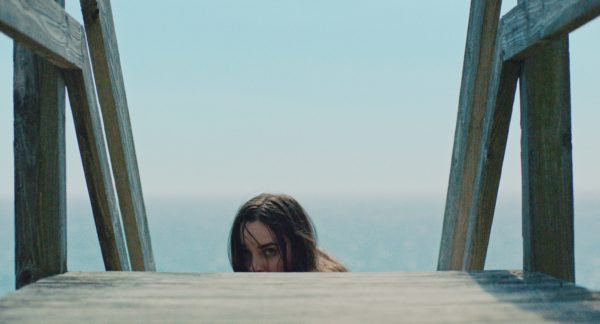
In He Said/She Said, critics Joe and Valeska dissect a film in a back and forth email exchange. Previously, we took a terrible summer vacation with a dangerous young girl in Becky, directed by Jonathan Milott and Cary Murnion.
Maybe the third time’s the charm as we try another weekend retreat with writer/director Jeffrey A. Brown’s cosmic aquatic horror film, The Beach House.
Full spoilers follow…
Synopsis: A romantic getaway for two troubled college sweethearts turns into a struggle for survival when unexpected guests – and the surrounding environment – exhibit signs of a mysterious infection.
HE SAID
Well Valeska, I’m intrigued to see how you respond to this film as I don’t know your appetite for cosmic horror. I’ll confess that I am not normally a fan, but in this case, Brown’s script wisely dedicates a substantial amount of The Beach House’s runtime to getting to know the characters. This way when things turn a little hallucinatory, the audience is more invested in their fate.
Like so many horror films, The Beach House is, at its core, the story of a toxic relationship. In this case, our protagonist Emily (Liana Liberto) and her boyfriend Randall (Noah Le Gros) are using a getaway weekend to reconcile after a bumpy period in their relationship. It turns out that Randall has flaked on his university career following an existential crisis about his future; this is in sharp contrast to Emily’s laser-focused plan to pursue her Masters in Organic Chemistry.
Let’s get this out of the way early on: Randall is a total dick and this is not a good relationship. The early part of the film uncomfortably documents his weak excuses to explain away his bad behaviour and Emily, sadly, lets him. If I had one major complaint about the film, it’s that there’s a lack of closure wherein Emily realizes that Randall sucks (I know, we’re meant to be satisfied with the end of their relationship later in the film, but that moment doesn’t hit hard enough for me).

Their plans are exacerbated by the sudden, unexpected arrival of a pair of Randall’s dad’s friends: Mitch (Jake Weber) and Jane Turner (Maryanne Nagel) who have, unbeknownst to the College kids, been staying at the family cottage. The two couples agree to share the space and, in short order, Jane is revealed to be sick with an undisclosed illness (heavily inferred to be cancer). Naturally that’s not the real threat, though, as something in the water appears to be infecting people, slowly transforming them into mindless decomposing creatures that infect and assimilate others.
In some ways, Valeska, this is a collage of two different kinds of films: the uncomfortable thriller wherein unlikely groups of people are forced into close confines and an aquatic/cosmic film complete with goopy body horror and plenty of fog. Whereas the film feels a bit familiar in its first half, it does have a lot of striking imagery, particularly Brown’s repeated use of close-up shots of liquids and sea life, which makes them look alien and threatening in equal measure.
Perhaps this is where I’ll kick it over to you, V: what were your initial thoughts on the film? Did the transition from thriller to cosmic horror mesh for you? Were you onboard with Emily’s journey from push-over girlfriend to sole survivor? And what do you make of that (sure to be controversial) ending?
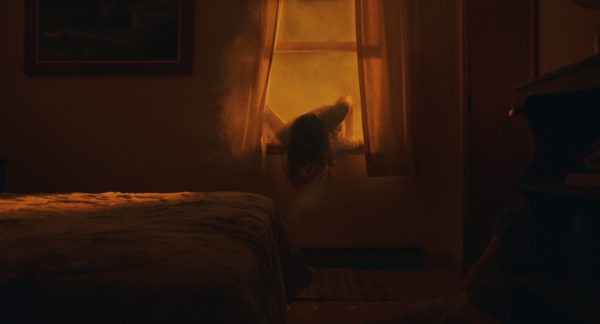
SHE SAID
When the film began, I had trouble believing that any setting so lavishly decorated in surfy pastels could be the site of much horror, apart from maybe running out of sunscreen or BBQ sauce. Maybe it’s the quarantine talking, but I think I’d be okay with spending a weekend in that summer home even with the havoc that follows.
Which is as good a segue as any to lead into my read of the film: I think that The Beach House is a perfect horror film for this moment; a film that lives in an intersection of climate crisis and infection horror. During the foursome’s first night at the titular beach house, Emily’s fascination with astrobiology leads to a number of dreamy monologues on the origins of life and the delicate balance of conditions required to transform “chemistry into biology.” As we’re gifted with the appearance of some truly incredible-looking (and dangerous) “new” aquatic life the next afternoon, these conversations are more than just time-filler. As Emily explains to Jane (gosh, Maryanne Nagel is so great in this role), the depths of the ocean are a holy grail for a scientist hoping to crack the code of creation.
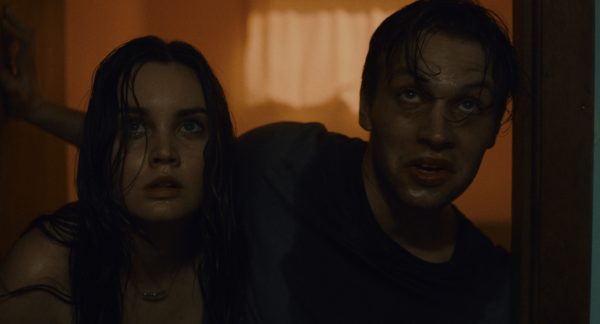
Later in the film, while desperately trying to find information about the hellish ordeal that she and Randall are barely surviving, Emily finds a radio and tunes into the only AM channel still broadcasting; the message being relayed is one from the Oceanographic Research Institute, revealing that the earth’s heat has been causing bacterial forms to bubble to the surface. It’s a throwaway line, slightly garbled and easily missed. But it’s this line along with an earlier complaint about the heat that gestures toward a chilling revelation: our environmental irresponsibility has wrought more than just the expected loss of ice caps, drought, and famine. This recklessness has triggered the appearance, evolution, or migration of aquatic parasites and airborne environmental hazards that mean the end of the world as we know it.
In the time of covid19, the infectious fog is an especially striking and prescient addition to this film’s collection of scare tactics. I hesitate to say it is ‘good timing’, but the airborne infection angle certainly hits harder now than it would have a year ago.
My overall impression? I loved it. I loved the build, I loved the characters (especially Mitch and Jane), and I loved the effects. As to your question about Emily being a pushover, I’m not sure I ever saw her that way. I saw a girl who was just about done with a relationship that was on its last legs—I’m not sure she would have stayed with him much longer, regardless. I saw a girl who is used to being able to think her way through problems and perhaps thought for a while that she could fix her ailing relationship. She’s certainly not a pushover.
Do you think the ending will be controversial? I found it par for the course, but I do tend to gravitate toward bleakness and nihilism in my horror. I really didn’t expect anything other than what we got, but I was perfectly fine with it! (My only tiny quibble is that, judging by her eyes, she was too far gone to have been speaking coherently.)
Joe, what did you think of the performances? Were you as heartbroken by Mitch’s second-act stroll as I was? And how did you feel about the creature design?
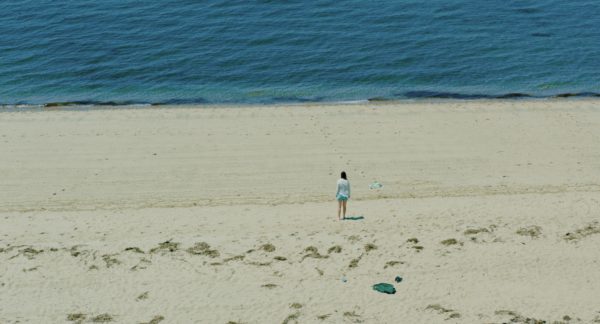
HE SAID
I suppose I’m conflating controversy with a disproportionate number of people being unhappy with the film’s resolution. Emily must endure quite the ordeal in this film; it’s a veritable emotional and physical gauntlet (a grotesque foot injury, Jane’s attack, the drive to the neighbour’s house, survive Randall’s transformation and a car crash and then…die). No one can say that Emily isn’t put through the wringer in this film!
Ultimately the end of the film is expected and beautiful and nihilistic. It’s also exceptionally sad and powerful. Days later, I’m still thinking about the image of a girl being washed away in the surf. It’s haunting.
Ultimately the visuals are a vital component of The Beach House’s power. I feel like I’ve fallen into a rut lately wherein I describe the narrative of a film as “simple, done well.” The Beach House could arguably fall into that category because there’s not a great deal to the narrative. And yet, to suggest that it’s not masterfully created would do it a major disservice. The horror of the situation is achieved in creeping dread and magnificently evocative visual imagery. Mitch’s exit – both an extreme long shot and a long take – as he literally walks to his death in the ocean is so powerful and elegant in its simplicity. It’s stunning.
And to think that it’s immediately followed by Emily’s foot infection, which requires her to pull an exceptionally long worm/sea creature out of a wound in her foot with tongs and a splash of white vinegar. Oof, oof, OOF! It’s icky, gross and squirm-worthy – otherworldly-looking enough to be creepy and authentic enough to resemble a real-world mutation.
Ultimately it’s not difficult to understand why there’s a significant amount of buzz surrounding The Beach House. It’s intelligent, exceptionally well-acted and filled with a generous amount of creatures and evocative imagery. It’s a strong 8.5/10 for me.
V, was Mitch’s demise your favourite scene or did something else top that moment? How do you feel about the sequence in the neighbour’s basement? And what is your score for The Beach House?
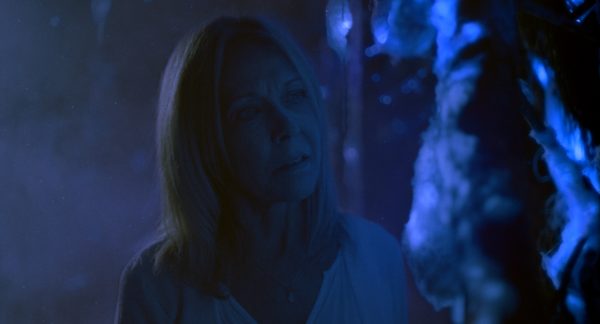
SHE SAID
Oh, Joe, this film has so many stunning scenes and moments. Visually, I loved Mitch’s walk, the first night’s bioluminescence, the aforementioned extreme close-ups, and the initial shot of the eerily empty neighbourhood. In terms of character moments, I adored Mitch and Emily’s discussion about the fear of change, Emily waxing poetic on the science of life while blissfully stoned, and Jane’s childlike joy at the glowing beach. Emily’s horrifying police radio conversation on the foggy second evening was particularly effective — as was the basement scene! Oof, just thinking about it makes me shiver!
I give The Beach House a 9/10, and it’s one of the very few films we’ve covered for this column that I revisited less than 24 hours after a first watch. Don’t sleep on this one, folks!